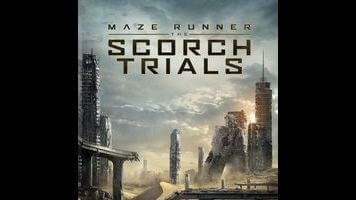The Maze Runner sequel features no mazes, but plenty of running

Late in the Maze Runner sequel The Scorch Trials, generic YA protagonist Thomas (Teen Wolf’s Dylan O’Brien) chooses to walk into a major confrontation he could have avoided. “Why didn’t you run?” another character asks. “I’m tired of running,” Thomas growls. It’s meant as a declaration of purpose, a significant shift in his thinking, much like the meaningful look into the camera in the final shot of The Hunger Games: Catching Fire. Instead, it comes across as unintentionally comic, because Scorch Trials is basically Fleeing In Terror: The Movie. After more than two straight hours of running and screaming, screaming and running, no wonder Thomas is tired. Even marathoners gotta rest sometime.
The Scorch Trials, which adapts the second book in James Dashner’s bestselling Maze Runner YA trilogy, has a bad case of middle-book syndrome. It comes with a few new revelations about the dystopian future where Thomas and his friends are guinea pigs in a vast medical experiment. But they merely amount to “everyone is out to get us,” repeated over and over, with each new betrayal followed by panicked flight across the wilderness. The YA book and film dystopias of the past seven years have often been unrelentingly bleak, and Maze Runner is no exception. But after an hour and a half of mechanical 10-minute action cycles that start with, “Maybe we’re safe now, for the moment,” and end with “Aaaah! Run!” the pattern gets as wearying as the level of emotional brutality. After a point, it feels like fully a quarter of the script is minor variations on “Go, go, go!” and “Faster! They’re gaining on us!”
Plot-wise, the film takes up just moments after Maze Runner leaves off. Thomas and a few friends, including token-maze-girl Teresa (Kaya Scodelario), why-isn’t-he-the-protagonist badass Minho (Ki Hong Lee), and quiet Newt (Game Of Thrones’ Thomas Brodie-Sangster) have survived the giant death-maze experiment where the first film took place, and have been spirited to safety by a sort of post-apocalyptic Navy SEAL team. They’re deposited in a techno-fortress run by the supposedly benevolent Janson (Aidan Gillen, Game Of Thrones’ Littlefinger, who has lost any ability he ever had to convincingly project benevolence). The fortress contains dozens of survivors from other mazes, whom Janson is shipping out in batches to a safer location. The irony that he literally claims they’re going away to rest and play on a nice farm somewhere won’t be lost on anyone in the audience.
So when a nervous survivor named Aris (Jacob Lofland) recognizes Thomas as the film’s protagonist and singles him out as an ally, it kicks off a new wave of horrible, depressing realizations about their devastated world and the ruthless people who rule it. Soon, Thomas and company are trying to move fast enough to stay ahead of Janson and his people. Then they’re pursued by plague-ridden people who have degenerated into zombie-like monsters called “cranks.” Then human pursuers come after them, then cranks again, and so on and so forth. At one point, they even take a page from M. Night Shyamalan’s The Happening and try to outrun a storm. Scorch Trials feels like the movie-long chase scene of Mad Max: Fury Road, complete with the ragged grubbiness of the setting, but on foot instead of in a ragtag flotilla of vehicles, and without any of the giddy glee. At least Fury Road’s War Boys were happy to be headed to Valhalla. There’s no joy in anything in the Maze Runner movies, and little practical purpose. There’s just a sense that the characters are trying to postpone death for a few minutes longer.
Special-effects engineer Wes Ball, who made his directorial debut with The Maze Runner, continues to show off his strengths with this film: All these chases get redundant and exhausting, but he keeps them visually kinetic, and finds plenty of thrilling variations on ways to shoot running people. The chases are repetitive, but intense. While the film lacks Maze Runner’s Terrence Malick-inspired lushness, it’s still expensively and memorably designed. It even has its sublime moments, most notably when the leader of a scavenger outpost (Breaking Bad’s Giancarlo Esposito) plays Patsy Cline’s “Walkin’ After Midnight” in full over his realm’s PA system as armed outsiders invade. Ball lets the sequence stretch out, setting up an eerie calm before combat. It’s a beautiful tension-building sequence, heightened by the certain knowledge that neither the character nor the director would maintain the mood so long if the payoff wasn’t going to be explosive and memorable.
But Scorch Trials still feels like it’s wheel-spinning, in a movie where virtually none of the characters have access to wheels. The useful information it conveys, about the ways various baddies led by Patricia Clarkson are trying to cure the crank-creating plague, could fit into a short expository speech, which makes the film’s 131-minute runtime feel self-indulgent and bloated. Like The Maze Runner, the sequel ends with a setup for the next film: “So what’s your plan?” a character asks Thomas, after catastrophe and a cliffhanger. Even though Thomas doesn’t offer an answer before the cut to black, the line still feels like the highlight of the movie, because it implies that there might be a plan someday. One that hopefully involves less running.